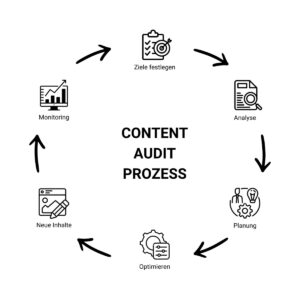In the heart of the B2B marketing is the art of convincing through effective content. This guide covers all areas of content auditing - your key to a stronger online presence, improved customer loyalty and higher ROI.
The most important facts in brief: Key learnings on the B2B content audit
- Regular content audits are essential for your marketing success
- Make data-based decisions with the right tools
- Qualitative analysis explores the meaning, context and value of your content
- In B2B in particular, content must fulfil certain standards in order to promote market positioning
- Extending the content audit to include competitor content reveals opportunities and potential
- Find strategies to keep content fresh, relevant and optimised thanks to Content Audit
What is a content audit?
A content audit is a thorough process in which all content on a website is systematically examined and evaluated in order to optimise its effectiveness in terms of SEO and the achievement of B2B marketing goals.
The aim is to identify the strengths and weaknesses of existing content, improve the user experience, increase search engine rankings and ultimately boost the conversion rate.
An effective content audit enables organisations to make informed decisions about updating, redesigning or eliminating web content and to align their content strategy.
Why conduct a content audit: The need for content analysis
For B2B organisations, a content audit is essential to ensure that their content strategy matches the specific needs of their target audience and the demands of the market. In the B2B context, where purchasing decisions are often based on extensive research and trust, high-quality, relevant and up-to-date content plays a key role.
Such digital content audits enable companies to precisely analyse the performance of their content, identify potential for improvement and optimise content in such a way that it increases visibility in search engines, improves the user experience and ultimately increases conversion rates. It also ensures that each piece of content is precisely aligned with the company's objectives and the needs of the target group.
Discover in our guide how B2B content marketing can advance your company through targeted content. Perfectly complementary to the content audit, this guide offers strategic insights to efficiently achieve your marketing goals. Read more about our B2B content marketing guide.
Preparing for the content audit: what is the goal?
At the beginning of a content audit is the Clear definition of your goals. Ask yourself what you want to achieve with the audit.
Do you want to improve SEO performance, optimise the user experience or check that content is up to date? In the B2B context, increasing lead quality, raising brand awareness and supporting the sales funnel are particularly relevant objectives.
It is also useful specific key performance indicators (KPIs). These help you to measure the success of your audit. They could include organic traffic, conversion rates, engagement metrics or the number of leads gained. For example, time spent on a page is often an indicator of content relevance and the number of page views per visitor is an indicator of engagement.
Quantitative content audit analysis: utilise the power of data
A quantitative content audit is crucial for the systematic evaluation of your online content. It enables the collection of critical data points that form the basis for targeted optimisation strategies.
The use of tools as part of a quantitative content audit is essential in order to effectively collect, analyse and interpret large amounts of data. Tools such as the Google Search Console, Google Analytics or Screaming Frog enable the effective collection and analysis of important metrics.
Automating the process with tools not only saves time, but also enables informed content optimisation decisions to achieve your B2B marketing goals more effectively.
Our technical website audit checks your website's CMS, themes, plugins, indexing, performance, loading times and Google rankings. The aim is to improve the user experience and offer suggestions for improving performance. At the end, you will receive a catalogue of measures for optimisation.
Key metrics of the quantitative content audit
- Page views and dwell time: Measuring interest and retention.
- Bounce rates: An indicator of the relevance of the content.
- Organic traffic: Shows the visibility in search engines.
- Keyword performance: Determines the effectiveness of the SEO strategy.
The interpretation of this data makes it possible to recognise patterns and trends that provide information about the performance of your content.
In contrast to a website audit, which primarily looks at technical and SEO aspects, the content audit focuses on content and relevance itself. The website audit, on the other hand, emphasises metrics such as structure, metadata, redirects and much more.
Ideally, content and website audit go hand in hand in order to obtain and evaluate sufficiently quantifiable data. Together, they provide precise, data-driven insights.
Qualitative analysis as part of a content audit
While a website content audit covers technical aspects such as the website structure or meta tags, the qualitative content audit focusses on the meaning, context and value of the content. It refers to how content conveys the brand message and resonates with the target group.
Qualitative analysis is an in-depth process that goes beyond mere metrics. Especially in the B2B sector, it is crucial to analyse the tone and substance of the content to ensure that it deals with complex topics appropriately and appeals to specialist audiences. Since the purchase decision takes longer, high-quality content is a must.
Another aspect can be the examination of content consistency in order to ensure a uniform brand message. This includes checking for cross-media synergies between text, image and Video and interactive elements that can increase user loyalty.
Factors in a qualitative content audit
- User experience: Is the content user-friendly and does it offer a pleasant reading experience?
- Relevance: How well does the content address the specific questions and needs of your target group?
- Authority: Does your content underpin the expertise and credibility of your company?
- Action orientation: Does the content encourage engagement and conversions? How effective are calls to action and are they correctly placed? (For example, download offers or enquiry options)
- Quality: High quality should not only be maintained in terms of content. Headings, titles and meta descriptions should also be present, correctly formatted and accurately formulated.
Interpretation of the qualitative data
- Content consistency: Checking the consistency of content across different formats and channels.
- Relevance to action & commitment: Evaluation of whether and how the content encourages users to take the desired action. Does this interaction have an effect on the customer journey?
- Tonality: Ensure that the tone of voice of the content reflects the brand personality and meets B2B requirements.
- Context: How does the content fit into the current market situation and developments in your industry?
SEO content audit: synergy between SEO and user data analysis
Analysing user data as part of a content audit provides deep insights into how visitors interact with your content and is crucial to understanding content effectiveness.
The integration of SEO-The integration of user data and metrics into the analysis of user data enables a comprehensive evaluation of content performance that takes into account both the needs of users and the requirements of search engines.
SEO metrics relevant for a content audit
- KeywordsSearch terms are essential for the findability of your content in search engines. Identify the terms that your target group is actively searching for and use them to derive topics for your content. By analysing user data such as search queries and click behaviour, you can see which keywords your target group uses and how successfully your content is positioned in the search results.
- Organic trafficIt shows how well your content ranks in search results and how many users visit your website via search engines. By analysing user data such as page views, dwell time and bounce rates, you can measure how many visitors come across your content via unpaid search and how much time they spend on it. Are you meeting users' expectations?
- Search engine rankingsMonitor where your content ranks for relevant keywords in search engines to understand the visibility and authority of your website. Then optimise your content specifically to improve your positioning and become even more visible.
The SEO content audit paired with the evaluation of user data is crucial in order to develop a holistic content optimisation strategy that addresses both the requirements of search engines and the needs of users.
While SEO metrics are important indicators for the visibility and findability of your content, user data provides valuable insights into the actual behaviour and needs of your target group.
Our SEO audit combines technical and content analyses of your website to uncover optimisation potential. It includes checking the technical status, Google positioning, keyword distribution, headings, structure and internal and external links. The aim is to improve website performance and user experience. Finally, you will receive a detailed catalogue of measures.
Recommendations for action and optimisation after a content audit
At the end of a content audit, you will receive an overview of your assets and transparency regarding the contribution of each individual piece of content. The results provide the basis for measurable improvements and show low-hanging fruit - where improvements can be made quickly and easily.
Based on the results of the audit, the recommendations for action include the following steps:
- Prioritisation of optimisations: Focus first on content that is crucial to your strategic goals. Take SEO priorities into account, such as high-ranking keywords or pages with high traffic potential or a high engagement rate.
- Updating and improvement: Revise content to keep it up-to-date and relevant. Integrate the latest information, optimise SEO elements such as keywords, meta descriptions and alt texts, and improve the user experience through fast loading times and mobile optimisation.
- Elimination and merging: Identify redundant or underperforming content. Decide whether it makes more sense to remove or merge with other content to consolidate SEO strength and avoid duplicate content.
- Strategic realignment: Use the insights to realign your content strategy and ensure that it meets the needs of your target group. Also take into account Trends and market developments.
- Implementation and management: Implement the planned changes and manage the process through clear schedules and resource allocation.
- Continuous monitoring: Monitor the performance and rankings of optimised content and adjust your strategy based on feedback and performance data.
Create a clear and targeted structure from your results if this is not already in place. With some B2B sites, we see that they started out more as a "business card" or only serve as a rudimentary product presentation. Here it is important to consider what the buyer's journey is like and what content is still missing in this construct in order to generate leads or close deals.
Carry out a content audit: Step by step through the content audit process
A comprehensive audit of your content is key to maximising the effectiveness of your digital content strategy. This systematic process not only sheds light on how well your content aligns with your company's goals and the needs of your target audience, but also provides valuable insights to optimise your online presence.
The phases of the content audit process
- Target definition and scope determination: Clarify the goals of your content audit at the beginning. Do you want to improve SEO performance, optimise the user experience or check that content is up to date? Determine which content should be analysed and the scope of the audit.
- Analyse the existing content: Carry out a combined quantitative and qualitative analysis to assess the performance of your content. Use SEO tools to capture metrics such as page views and organic traffic and evaluate content for quality, relevance and targeting.
- Resource planning: Decide whether you want to use internal teams or external service providers to carry out the audit. Take into account the availability of expertise as well as the necessary tools and technologies.
- Optimisation and adaptationIdentify optimisation potential based on the analysis results. This may include updating, redesigning or removing content. Implement the necessary changes to improve your content strategy.
- Creation of new contentBased on the findings from the analysis and the gaps identified in your content strategy, you will develop and implement new content. This includes creating content that is aligned with current market trends, user needs and SEO requirements. Also consider the development of content formats that were previously underrepresented or appeal to new target groups.
- Monitoring and evaluationMonitor the impact of the optimisations performed on your target metrics. This helps to measure the success of the audit and provides insights for future content strategies.

Competition analysis as an in-depth element of a content audit
The competitive analysis can be seen as a specific variant of a content audit. It offers the opportunity to gain deeper insights into the market position of your company in comparison to your competitors.
While a comprehensive content audit examines all aspects of your content strategy, the competitive analysis focuses specifically on how your content compares directly with your competitors' offerings.
This approach is particularly valuable for identifying unique selling points, recognising content gaps and making strategic optimisations.
Carrying out a competitor content audit
- Identification of competitors: Find out who your direct and indirect competitors are and what the benchmarks are in your industry.
- Analysing content gaps: Use your competitors' unique keywords to identify areas where your content could be enhanced.
- Identification of optimisation potential: Analyse shared keywords to see where your content stands in comparison to the competition and how you can improve it.
- Structural potentials: Evaluate the content process of your competitors in order to recognise structural strengths and weaknesses in your own content strategy.
Conclusion: After the content audit is before the next audit - stay agile
A one-off content audit is the start of a continuous process. Regular audits are crucial in order to stay technically up to date and continuously sharpen content. They help to avoid redundancies, close gaps and update content.
This cyclical approach helps companies to achieve marketing and content goals and maximise ROI. It also enables agile content development: Flexibility, continuous improvement and iterative working.
It's about adapting content quickly, based on constant feedback and performance data. Instead of planning large one-off publications, content is created, reviewed and optimised in shorter cycles.
Always take into account seasonal factors, market changes and buying cycles in order to utilise your resources efficiently and avoid unnecessary actions. Regular audits therefore form the foundation for a dynamic and effective content strategy.
Maximise your online potential: Professional content audit services
Utilising our content audit services at B2IMPACT can be the turning point for your digital strategy. With an in-depth analysis of your online content, we identify strengths and optimisation potential to position your company clearly and effectively in the digital space.
Our Customer Glasscube has already experienced significant improvement options through a comprehensive audit of its website. If you want to take your content strategy to the next level without straining internal resources, we are ready to support you.
Discover how GlassCube improved its online presence in the construction industry through a content audit including technical analysis and targeted marketing strategies. Read the full GlassCube success storyto find inspiration for your own marketing.
Act now for sustainable content: Start with a professional content audit from B2IMPACT. Get in touch with us today for an individual consultation and take the first step towards an optimised online presence.
With B2IMPACT at your side, you can sharpen your digital profile and secure your competitive edge in an ever-changing digital landscape.











